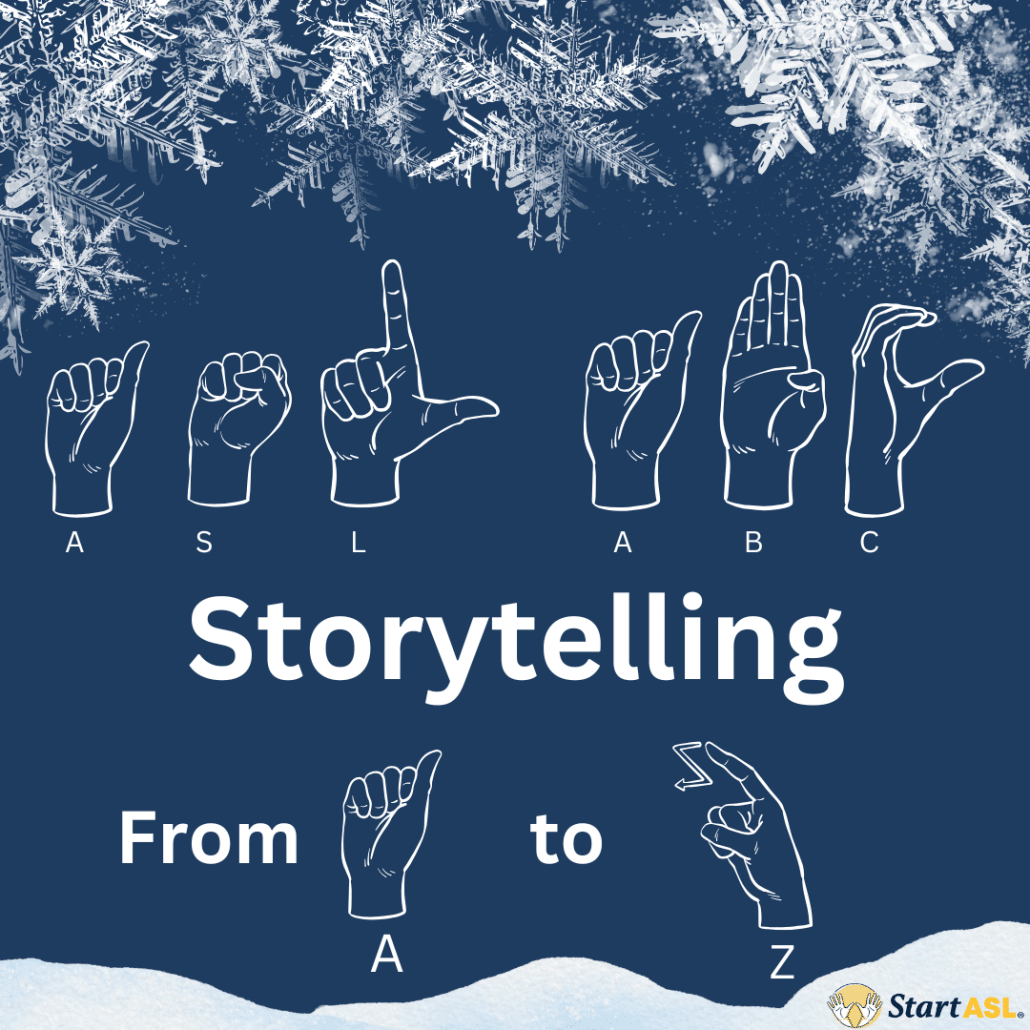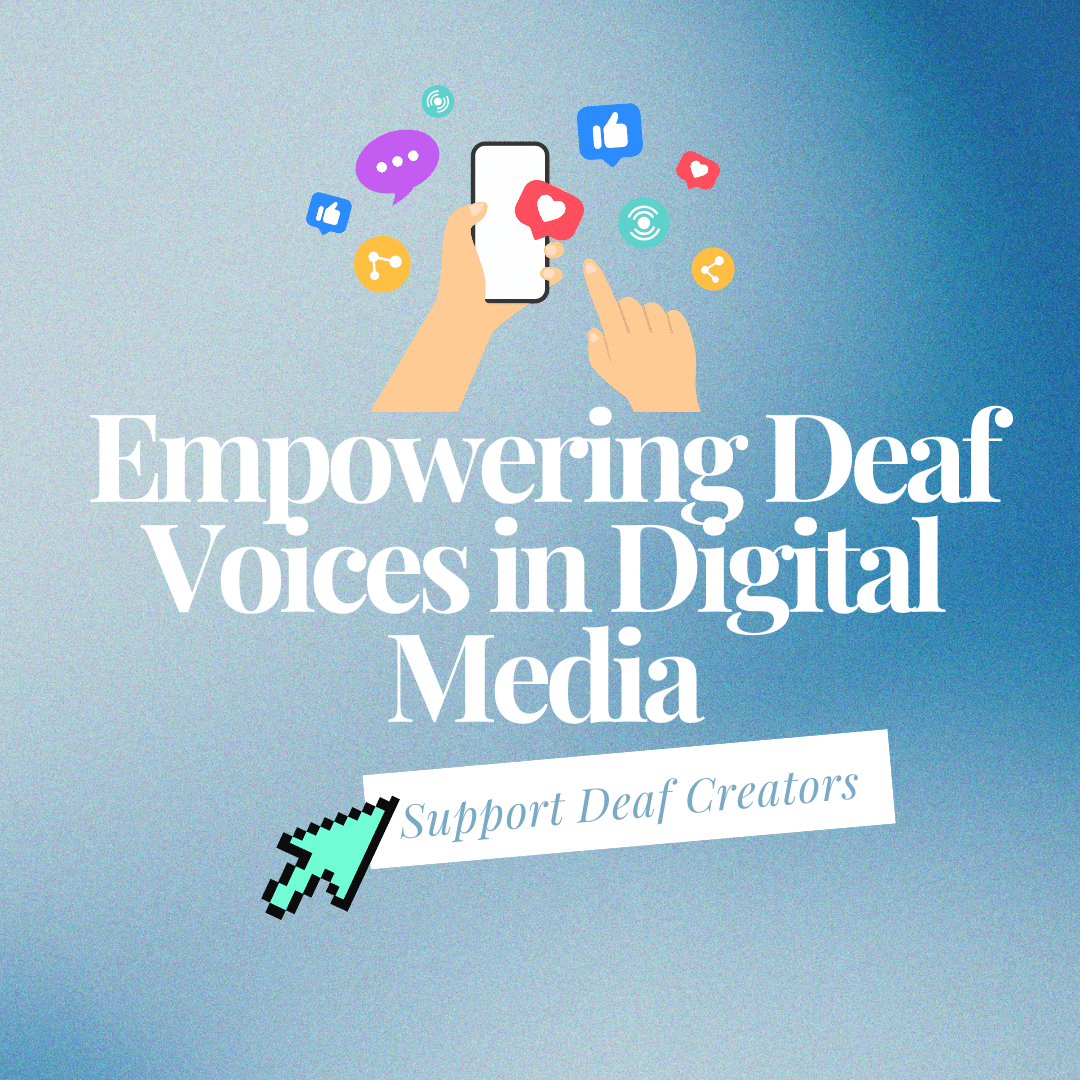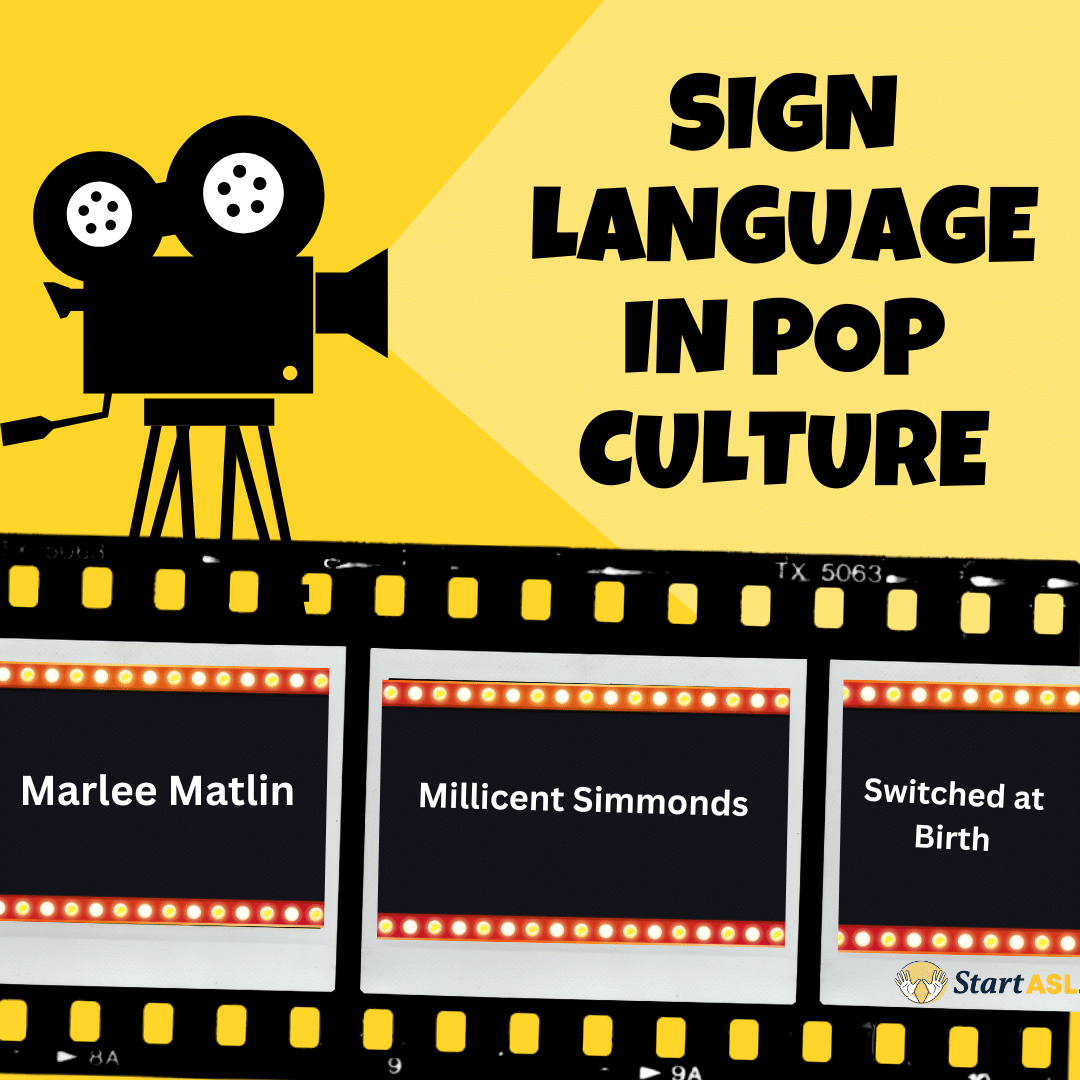
ASL ABC Storytelling: What Is It and Holiday ABC Story
- by Tech Amin
- No Comments
By Megan Clancy
American Sign Language (ASL) can be considered an art form in various ways, particularly when it is used to convey emotion, storytelling, and culture through its unique visual and expressive qualities. A popular ASL art form includes ABC stories where the signer creates a story by using handshapes starting with the handshape A then ending with the handshape for ZZ. This is like playing with ASL by using creativity.
Here are some ways in which ASL is recognized as an art form:
Deaf Theater and Performance Art: ASL is often used in performances in Deaf theater, where actors use sign language as the primary medium of communication. In this setting, ASL becomes an art form in the way it conveys emotion, character development, and narrative. Deaf theater troupes may incorporate storytelling with signs, body language, facial expressions, and movement, creating a performance that is rich in visual imagery and depth.
Poetry in ASL: ASL poetry is a genre where the language itself becomes the artistic medium. ASL poets often play with rhythm, hand shapes, facial expressions, and movement to create a visual, emotional experience that transcends simple communication. Much like spoken poetry, ASL poetry can be abstract, poignant, and deeply expressive, but it uses the full range of the visual-gestural modality.
Dance and Movement: ASL can be combined with dance to create expressive works that use both gesture and body movement. The fluidity and rhythm of ASL signs lend themselves naturally to choreography, where the body itself becomes a canvas for artistic expression. In these performances, ASL signs are often used to convey themes, while the movement and space bring an added layer of meaning and beauty.
Visual Art and ASL: ASL can also be used in visual arts like painting or sculpture, where sign language might be depicted through imagery or design. Artists may use symbols, hand shapes, or the concept of “space” in ASL to create works that represent or celebrate Deaf culture and the language itself.
Storytelling: ASL is a language that is rich in visual storytelling, and Deaf storytellers often use the language in an artistic way. With ASL, storytelling can be highly visual, with different signs and facial expressions used to convey emotion, atmosphere, and tone. The performer uses the hands, facial expressions, and body posture to create vivid mental pictures for the audience, making it both a linguistic and artistic endeavor.
Film and Media: Deaf filmmakers and media creators have used ASL to craft films and videos that highlight the expressive potential of sign language as a storytelling medium. In these films, ASL is not only a way of communicating but also an artistic vehicle for conveying complex themes, emotions, and visual narratives.
In all of these cases, ASL is much more than just a practical form of communication—it becomes a means of creating art that engages the audience visually, emotionally, and intellectually. Its beauty lies in its use of space, its embodied nature, and its ability to express nuanced meaning through gestures, facial expressions, and movements that go beyond the written or spoken word.
ABC Stories in American Sign Language (ASL) is a form of visual storytelling where each sentence or word begins with a different letter of the alphabet. These stories are often used to showcase the beauty and creativity of ASL, helping to build fluency while engaging the audience with a unique narrative structure.
Here’s a closer look at how ABC stories work and their importance in ASL:
Structure of ABC Stories:
ABC stories in ASL itself are not the same as those written in English. ABC stories in ASL are a visual way of using handshapes starting with the letter A then ending with the letter Z. However, in written English itself, you can start with a word that starts with A then ending with a word that begins with Z.
Alphabetical Order: In an ABC story, each sign starts with the corresponding handshape of the letter of the alphabet starting with the letter A then moving on to the next letter until it ends with the handshape for the letter Z. For example, if the story is about baking a pizza, the story can start with the handshape A signing opening up the bag of dough. Then moving on to the letter showing handshape B which shows pounding the dough, and so on then ending the story with the handshape and movement for Z showing a finger spreading spices on the pizza.
Creativity: ABC stories often require the storyteller to think creatively, as they need to come up with signs, words, or ideas that correspond to each letter while still maintaining a cohesive story. This structure challenges the signer to be expressive and inventive with the signs.
Visual & Artistic Element:
The beauty of an ABC story lies in the fluidity of transitioning from one letter to the next while maintaining a natural storytelling flow. The signer will often use facial expressions, body language, and space to enhance the meaning of the words, making it a highly visual art form.
Since ASL is a visual language, the gestures and movements become more than just signs—they convey emotions, actions, and ideas that add layers of depth to the story.
Educational Tool:
Language Learning: ABC stories are a fun and effective way to teach ASL, especially to beginners. They help learners get familiar with the alphabet, improve their signing skills, and build vocabulary.
Memory Aid: Because each letter corresponds to a sign, learners often find it easier to remember signs in sequence, reinforcing their understanding of the language and its structure.
Performing ABC Stories:
Flowing Movements: The signer must create smooth transitions from one letter to the next, using appropriate pauses or changes in facial expressions and movements.
Engagement: The signer often uses storytelling techniques like rhythm, timing, and emotion to keep the audience engaged and convey the meaning of the story, while the structure of the ABC format adds a playful and challenging element.
ABC stories in ASL are a unique and artistic way of using ASL to tell a story. They showcase the expressive potential of the language and engage audiences through a structured yet creative format.
Let’s look at an ABC story for Christmas for example. You need to think in ASL handshapes, not the first letter of a word to make this ABC story work in ASL form. Don’t forget that ASL is a visual language that can become an art form. For example,
A: Using the handshape A positioned downward, this represents the thumping of children’s feet on the floor on Christmas morning. In American Sign Language (ASL), the handshape for “A” positioned downward can indeed represent the action of thumping or stomping feet on the floor, such as the excitement and energy often felt on Christmas morning.
Here’s how you can perform the sign:
- Handshape: Make the “A” handshape by curling your fingers into a fist, with your thumb resting on the side of the index finger, so the fist is pointing downward.
- Position: Hold both hands with the “A” handshape facing down toward the floor, with the palms facing each other.
- Movement: Move the hands downward in a quick, repetitive motion, mimicking the action of stomping or thumping feet on the floor. The hand movement conveys the rhythmic, excited thumping that children often make as they jump out of bed on Christmas morning to see presents.
This sign can symbolize the energy and excitement of waking up and running toward presents, commonly associated with the joy of Christmas morning. It’s a fun, expressive way to communicate the feeling and action of that moment!
B: Using the handshape B positioned downward, this represents the thumping of Santa Claus’ feet on the floor on Christmas morning. In American Sign Language (ASL), using the handshape “B” positioned downward to represent the thumping of Santa Claus’ feet on the floor on Christmas morning would work similarly to the description you mentioned for the “A” handshape but with a few key adjustments.
Here’s how to perform this sign:
Handshape:
- Make the “B” handshape by extending all four fingers (index, middle, ring, and pinky) straight up while keeping them together, and the thumb should be positioned out to the side. The palm should be facing downward.
Position:
- Hold your “B” handshape with both hands positioned downward, and palms facing toward the ground.
Movement:
- To mimic the thumping of feet, you would use a repetitive, quick, downward motion with both hands, slightly tapping or bouncing them against the imaginary floor. The movement should reflect the rhythm of footsteps hitting the floor, symbolizing Santa Claus’ feet thumping down on Christmas morning.
The visual of the “B” handshape in this motion would effectively convey the idea of Santa’s feet stomping or thumping as he makes his way through a house on Christmas morning. This sign uses both the specific handshape and downward motion to indicate the lively, energetic thumping associated with Santa’s presence. It’s a creative way to express an iconic moment of the holiday season!
FYI: In an ABC story, you can use different handshapes to support the continuity of a story.
Using different handshapes in an ABC story can enhance the continuity and creativity of the narrative in American Sign Language (ASL).
In an ABC story, the storyteller might employ various handshapes to help convey different actions, objects, or ideas while still adhering to the alphabetical structure. The variation in handshapes allows the storyteller to be more expressive and dynamic, supporting the flow of the story in a way that is visually engaging and culturally relevant.
Here’s how different handshapes might be used effectively in an ABC story:
Handshapes for Characterization:
- For example, if you are telling a story about Santa Claus, you could start with the “C” handshape to represent his beard, then use the “C” handshape to represent his sleigh or the reindeer. The variation in handshapes makes the story more visually interesting and gives a sense of progression.
Action Representation:
- If you want to describe actions, different handshapes can help differentiate one action from another. For example, the “A” handshape could represent a person or animal, while the “B” handshape could be used to indicate a flat object or something larger (like a gift). The handshapes add detail to what’s happening in the story.
Supporting Emotions or Atmosphere:
- The choice of handshapes can also convey emotions or set the mood. For example, the “C” handshape could be used to show something cuddly or round, whereas the “F” handshape might represent something fragile or delicate. These small adjustments help convey the tone of the story. Therefore this is where facial expressions are very important to show meaning of each concept.
Transitional Elements:
- Using different handshapes allows for smooth transitions between characters, objects, and actions while staying within the ABC structure. For instance, one handshape might represent a character at the start of the story, and as the story progresses, the handshape might change to represent another action or item that fits the letter of the alphabet.
By varying handshapes throughout the ABC story, the signer keeps the audience visually engaged and ensures the story flows smoothly while still following the constraints of using the alphabet. The creative use of handshapes and movement can make an ABC story not only educational but also a visually stunning piece of ASL art.
Basically, ABC stories in ASL are all about using one’s imagination, creativity, and storytelling skills by using ASL handshapes from A-Z.
Finding a Christmas-related word that starts with the letter “Z” is a bit tricky, as there aren’t many direct words related to Christmas that begin with that letter. However, here are a few creative ways to approach it:
- Zzzz (Sleep) – Refers to the sleep many people get on Christmas Eve, especially children eagerly awaiting Santa Claus. The “Zzzz” can be used to describe the quiet, peaceful sleep that comes before the excitement of Christmas morning.
- Zig-zag (Pattern) – Some Christmas decorations or wrapping paper may have zig-zag patterns, which could be a fun way to reference festive designs, especially for presents or Christmas trees.
For those who celebrate Hanukkah: Here are some ideas for creating an ABC ASL story:
Creating an ABC story in American Sign Language (ASL) about Hanukkah is a wonderful way to use the alphabet to tell a visually engaging and educational story. Here’s a simple ABC story concept centered around Hanukkah, where each sign will begin with a different letter of the alphabet, and I’ll suggest how different handshapes or movements might correspond to each letter.

ABC ASL Story: Hanukkah
D – Dreidel: Use the “F” handshape to represent the dreidel (the spinning top used in Hanukkah games). You can spin your hands in a circular motion to represent the action of playing with the dreidel.
E – Eating: The “O” handshape can represent eating or food in its flattened O handshape. You might describe the foods traditionally eaten during Hanukkah, such as latkes (potato pancakes) or sufganiyot (jelly doughnuts).
F – Family: Use the “C” handshape to represent family gatherings, which are often gathered together during Hanukkah celebrations. You can position both hands close to each other, symbolizing a gathering or closeness.
G – Gift: The “X” handshape can represent gifts. In many cultures, exchanging gifts is part of the celebration, so you can mime giving a present to someone.
J – Joy: The “I” and J handshapes can be used to represent the joy that people feel during Hanukkah. You might show joy through your facial expression and use your hands to convey the festive mood.
For those who observe Kwanzaa, creating an ABC story in American Sign Language (ASL) for Kwanzaa is a wonderful way to introduce the key elements of the holiday while demonstrating the beauty and expressiveness of ASL. Here’s an example of an ABC story about Kwanzaa, where each letter of the alphabet represents an aspect of the celebration:
ABC ASL Story: Kwanzaa ideas:
B – Basket: The “B” handshape can represent a basket, a symbol of the harvest during Kwanzaa. You might sign a basket and mime filling it with fruits or vegetables.
C – Community: The “C, handshape can represent a community gathering together. Kwanzaa is about bringing together family and community to celebrate unity and heritage. The “G” handshape can represent individual people.
D – Dance: The inverted “V” handshape can represent dance, a common part of Kwanzaa celebrations. You could show a joyful movement to represent dancing during the holiday.
J – Joy: Use the “I” and J” handshapes to represent joy, as Kwanzaa is a time of celebration and joy for the family and community.
Summary:
In this ABC story for Kwanzaa, each handshape of the alphabet corresponds to a different symbol, value, or practice associated with the holiday. The story incorporates the principles of Kwanzaa, along with cultural traditions, celebrations, and the spirit of community, making it an engaging way to share the meaning of Kwanzaa through ASL.
Happy holidays to all!
#StartASL #ASL #AmericanSignLanguage #SignLanguage #LearnASL #ASLCommunity #DeafCulture #DeafAwareness #ASLStudents #ASLClasses #LearnSignLanguage #SignLanguageForAll #ASLTranslation #ASLStorytime #ABCStoryInASL #ASLChallenge #SignLanguageStory #SignLanguageABC #ASLStoryTeller #DeafStorytelling #ASLAlphabet #ASLEducation #ASLVideo #SignLanguageFun #ASLCommunity










